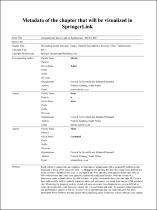 ResearchSpace
ResearchSpace
Developing spatial indicators using a uniform tessellation to measure urban transformation
JavaScript is disabled for your browser. Some features of this site may not work without it.
- ResearchSpace
- →
- Research Publications/Outputs
- →
- Conference Publications
- →
- View Item
| dc.contributor.author |
Maritz, Johan

|
|
| dc.contributor.author |
Le Roux, Alize

|
|
| dc.contributor.author |
Mans, Gerbrand G

|
|
| dc.date.accessioned | 2018-07-10T08:07:20Z | |
| dc.date.available | 2018-07-10T08:07:20Z | |
| dc.date.issued | 2017-07 | |
| dc.identifier.citation | Maritz, J., Le Roux, A. and Mans, G.G. 2017. Developing spatial indicators using a uniform tessellation to measure urban transformation. 2017 International Conference on Computational Science and Its Applications (ICCSA), 3-6 July 2017, Trieste, Italy, pp. 408-421 | en_US |
| dc.identifier.isbn | 978-3-319-62400-6 | |
| dc.identifier.uri | DOI: 10.1007/978-3-319-62401-3_30 | |
| dc.identifier.uri | https://link.springer.com/chapter/10.1007/978-3-319-62401-3_30 | |
| dc.identifier.uri | http://hdl.handle.net/10204/10298 | |
| dc.description | © Springer International Publishing AG 2017. Due to copyright restrictions, the attached PDF file only contains the author's proof version of the item. For access to the published item, please consult the publisher's website. | en_US |
| dc.description.abstract | South Africa’s largest cities are subjected to high rates of urbanization with a projected 8 million people migrating to these urban spaces by 2030 [ 1]. Managing and guiding this growth is made more difficult due to the countries ‘apartheid city’ past - a segregated city form inherited from the pre-democratic order in 1994 where towns and cities were spatially engineered along racial divides. With the advent of a democratic order in South Africa in 1994 a number of policy frameworks have seen the light all of which have indicated the need to spatially transform cities and settlements – to break from the pre-1994 apartheid city. Measuring the progress made in spatial and socio-economic transformation has proven difficult as some information have only been provided at city or Local Municipal scale. To measure spatial outcomes, city performance, quality of life etc. a series of local and international city scale indicators has been developed. These however are only useful when comparing cities; it does not convey sub-city scale change or transformation. This paper profiles an approach that uses a single-sized uniform tessellation to create demographic and economic indicators for nine cities and explores the utilisation of this tessellated framework to analyse and depict demographic and economic change over time. | en_US |
| dc.language.iso | en | en_US |
| dc.publisher | Springer | en_US |
| dc.relation.ispartofseries | Worklist;19665 | |
| dc.subject | City indicators | en_US |
| dc.subject | Spatial framework | en_US |
| dc.subject | Tessellation | en_US |
| dc.subject | Transformation of cities | en_US |
| dc.title | Developing spatial indicators using a uniform tessellation to measure urban transformation | en_US |
| dc.type | Conference Presentation | en_US |
| dc.identifier.apacitation | Maritz, J., Le Roux, A., & Mans, G. G. (2017). Developing spatial indicators using a uniform tessellation to measure urban transformation. Springer. http://hdl.handle.net/10204/10298 | en_ZA |
| dc.identifier.chicagocitation | Maritz, Johan, Alize Le Roux, and Gerbrand G Mans. "Developing spatial indicators using a uniform tessellation to measure urban transformation." (2017): http://hdl.handle.net/10204/10298 | en_ZA |
| dc.identifier.vancouvercitation | Maritz J, Le Roux A, Mans GG, Developing spatial indicators using a uniform tessellation to measure urban transformation; Springer; 2017. http://hdl.handle.net/10204/10298 . | en_ZA |
| dc.identifier.ris | TY - Conference Presentation AU - Maritz, Johan AU - Le Roux, Alize AU - Mans, Gerbrand G AB - South Africa’s largest cities are subjected to high rates of urbanization with a projected 8 million people migrating to these urban spaces by 2030 [ 1]. Managing and guiding this growth is made more difficult due to the countries ‘apartheid city’ past - a segregated city form inherited from the pre-democratic order in 1994 where towns and cities were spatially engineered along racial divides. With the advent of a democratic order in South Africa in 1994 a number of policy frameworks have seen the light all of which have indicated the need to spatially transform cities and settlements – to break from the pre-1994 apartheid city. Measuring the progress made in spatial and socio-economic transformation has proven difficult as some information have only been provided at city or Local Municipal scale. To measure spatial outcomes, city performance, quality of life etc. a series of local and international city scale indicators has been developed. These however are only useful when comparing cities; it does not convey sub-city scale change or transformation. This paper profiles an approach that uses a single-sized uniform tessellation to create demographic and economic indicators for nine cities and explores the utilisation of this tessellated framework to analyse and depict demographic and economic change over time. DA - 2017-07 DB - ResearchSpace DP - CSIR KW - City indicators KW - Spatial framework KW - Tessellation KW - Transformation of cities LK - https://researchspace.csir.co.za PY - 2017 SM - 978-3-319-62400-6 T1 - Developing spatial indicators using a uniform tessellation to measure urban transformation TI - Developing spatial indicators using a uniform tessellation to measure urban transformation UR - http://hdl.handle.net/10204/10298 ER - | en_ZA |





